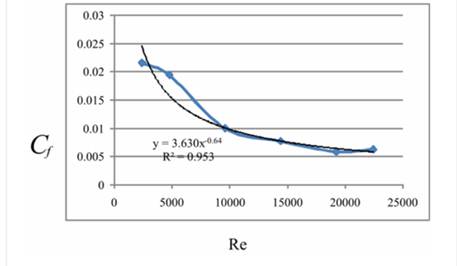
To rewrite:
This function in dimensionless form, using dimensional analysis.
Answer to Problem 5.1CP
The dimensionless function is
Explanation of Solution
Given Information:
For long circular rough pipes in turbulent flow, wall shear
Concept Used:
The number of pi groups are to be calculated:
Where k is the number of variables and r is the number of fundamental references.
On substituting 6 for k and 3 for r ,
Calculation:
Dimensional analysis is applied to find the pi groups.
First pi group:
Where
On substituting
On equating M coefficients:
On equating T coefficients:
On equating L coefficients:
Hence, a = 1, b = 1
Therefore, the first pi group is as follows:
Second pi group:
Where
On substituting
On equating M coefficients:
On equating T coefficients:
On equating L coefficients:
Therefore, the second pi group is as follows:
Third pi group:
Where
On substituting
On equating M coefficients:
On equating T coefficients:
On equating L coefficients:
Therefore, the third pi group is as follows:
Hence as per the choices:
On substituting
Where
Conclusion:
The dimensionless function is
To plot:
Data using the dimensionless form obtained, a curve fit formula and a single value of a range.
Answer to Problem 5.1CP
The data is plotted as above, the curve fit formula is
Explanation of Solution
Given Information:
Diameter of pipe, d = 5 cm
The following values of wall shear stress are shown by the measurements for flow of water at 20?:

Concept Used:
The parameter
As per the table (Moody chart):
The velocity is calculated as follows:
Reynolds number is calculated as follows:
The skin friction coefficient is calculated as follows:
Calculation:
On substituting 1.5 gal/min for Q and 50 mm for d in the calculation of velocity:
On substituting 998 kg/m3 for
On substituting 0.05 Pa for
Remaining values are also calculated similarly and tabulated as follows:
| V (m/s) | 0.0481972 | 0.0963944 | 0.1927888 | 0.2891832 | 0.3855776 | 0.4498406 |
| Re | 2405 | 4810 | 9620 | 14430 | 19240 | 22447 |
| Cf | 0.021567 | 0.019411 | 0.009975 | 0.007668 | 0.005796 | 0.00619 |
The curve is plotted between Cf versus Re:

The following equation shows the power law curve fit in the plot:
Hence, 95.3% is the correlation.
Hence, the curve is valid for only Reynolds number range of 2000-22000 and single
Conclusion:
The data is plotted as above, the curve fit formula is
Want to see more full solutions like this?
Chapter 5 Solutions
FLUID MECHANICS-PHYSICAL ACCESS CODE
 Elements Of ElectromagneticsMechanical EngineeringISBN:9780190698614Author:Sadiku, Matthew N. O.Publisher:Oxford University Press
Elements Of ElectromagneticsMechanical EngineeringISBN:9780190698614Author:Sadiku, Matthew N. O.Publisher:Oxford University Press Mechanics of Materials (10th Edition)Mechanical EngineeringISBN:9780134319650Author:Russell C. HibbelerPublisher:PEARSON
Mechanics of Materials (10th Edition)Mechanical EngineeringISBN:9780134319650Author:Russell C. HibbelerPublisher:PEARSON Thermodynamics: An Engineering ApproachMechanical EngineeringISBN:9781259822674Author:Yunus A. Cengel Dr., Michael A. BolesPublisher:McGraw-Hill Education
Thermodynamics: An Engineering ApproachMechanical EngineeringISBN:9781259822674Author:Yunus A. Cengel Dr., Michael A. BolesPublisher:McGraw-Hill Education Control Systems EngineeringMechanical EngineeringISBN:9781118170519Author:Norman S. NisePublisher:WILEY
Control Systems EngineeringMechanical EngineeringISBN:9781118170519Author:Norman S. NisePublisher:WILEY Mechanics of Materials (MindTap Course List)Mechanical EngineeringISBN:9781337093347Author:Barry J. Goodno, James M. GerePublisher:Cengage Learning
Mechanics of Materials (MindTap Course List)Mechanical EngineeringISBN:9781337093347Author:Barry J. Goodno, James M. GerePublisher:Cengage Learning Engineering Mechanics: StaticsMechanical EngineeringISBN:9781118807330Author:James L. Meriam, L. G. Kraige, J. N. BoltonPublisher:WILEY
Engineering Mechanics: StaticsMechanical EngineeringISBN:9781118807330Author:James L. Meriam, L. G. Kraige, J. N. BoltonPublisher:WILEY





